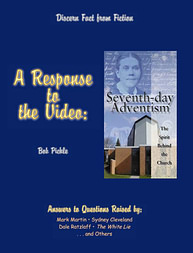|
A Response to the Video:
Seventh-day Adventism, the Spirit Behind the Church
by Bob Pickle
Answers to Questions Raised by:
Mark Martin, Sydney Cleveland
Dale Ratzlaff, The White Lie
. . . and Others
Discern Fact from Fiction
The Millerite Movement
< Prev T. of C. ... 10-11 12-13 14-15 16 17-18 19-20 21 22 23 ... Next >
| #17 &
#18: "Ellen's controversial vision forced the re-adjustment of
many Adventist dates and
doctrines."—Narrator. |
#17: This vision was controversial.
Neither her first vision nor her vision of September 23, 1850 (see #14), should have been
considered controversial at the time. Both appeared reasonable and middle of the road to
their targeted audiences.
At some point after October 22, 1844, there were two major and opposite divisions of
thought: 1) The 2300 days of Daniel 8:14 had not ended
yet and Christ's literal and visible coming was yet future. 2) The 2300 days had ended and
Christ had already returned in a spiritual way.
In contrast, Mrs. White's first vision indicated that the 2300 days had ended, but
Christ's return was yet future and would be literal and visible
like the Bible says. Thus it promoted a middle-of-the-road position between the two major
camps.
Fifty thousand Millerites had felt moved by the Spirit of God during the seventh-month
movement. Since her first vision indicated that that
movement was indeed of God, this point too should have been considered
non-controversial.
The 1850 vision the video quoted from, first published in November of that year,
taught that:
- There was nothing wrong with printing a periodical to proclaim
the truth.
- The word "sacrifice" in Daniel 8:12 was not in the original, but
had been added by the translators (an indisputable fact).
- "Time . . . will never again be a test." In other words,
there should be no more setting dates for Christ's return. [p.
25]
- Lots of money should not be spent sending people to Jerusalem,
thinking that somehow this will help fulfill prophecy. (Present
Truth, Nov. 1, 1850; Early Writings, pp. 74-76)
Nothing controversial here, though some who were setting dates might not have cared
for the third point. However, she had already been
opposing date setting for five years by that time, so this position was nothing new (see
Testimonies for the Church, vol. 1, pp. 72, 73).
Those who wanted to go to Jerusalem probably didn't like the fourth point, but this
wasn't controversial either, for it harmonized with what
the Millerites had believed and taught prior to 1844. They did not believe that the Bible
foretold a restoration of literal Israel, but felt that Israel
today is composed of all believers, as the apostle Paul taught:
For he is not a Jew, which is one outwardly; neither is that circumcision, which is
outward in the flesh: But he is a Jew, which is one inwardly;
and circumcision is that of the heart, in the spirit, and not in the letter. (Rom. 2:28, 29)
Know ye therefore that they which are of faith, the same are the children of
Abraham. . . .
If ye be Christ's, then are ye Abraham's seed, and heirs according to the promise.
(Gal. 3:7, 29)
This teaching may be controversial today, but it definitely wasn't among Millerites in
1844.
#18: It caused a re-adjustment of many dates and doctrines.
No dates were re-adjusted by either vision. The first vision didn't
really introduce any new doctrines. The 1850 vision called for a moratorium on date setting,
but that wouldn't constitute a re-adjustment of
many doctrines, especially since she had already been advocating that
position for five years. Going to Jerusalem not being a fulfillment of
prophecy was already a standard Millerite doctrine, so this doctrine was not re-adjusted
either.

|

|
Like this book?
Save your printer and your ink!
Buy the entire 160-page book for
just
$9.95 + S/H.
Automatic discounts start
at 5 copies.
|
|
|
< Prev T. of C. ... 10-11 12-13 14-15 16 17-18 19-20 21 22 23 ... Next >
| 


